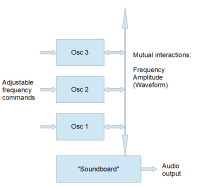Simulating tone generators that interact via a soundboard

Sound synthesisers usually have tone generators that don't interact with each other. In real polyphonic stringed instruments (acoustic guitar, piano, harpsichord...), the strings are stretched over a common soundboard, so the vibration of one string modulates the frequency, amplitude and perhaps the waveform of any others that are free to vibrate.
Sound synthesisers usually have tone generators that don't interact with each other. In real polyphonic stringed instruments (acoustic guitar, piano, harpsichord...), the strings are stretched over a common soundboard, so the vibration of one string modulates the frequency, amplitude and perhaps the waveform of any others that are free to vibrate.
I'd like to be able to simulate this, but havn't yet found a ready-made (free) synthesiser that can do it. To begin with, the tones could be sinusoids (which can be distorted downstream by an effects unit), and for experimental purposes I'd need only 2- or 3-note polyphony. Apart from music-making, I want to learn how to tune instruments by ear, without wearing out tuning pegs or breaking strings. To do this, I set up a project using an Arduino with a MIDI keyboard and an old Roland JV synthesiser/expander (http://www.music.chrblee.net/tuningaid).
Normally, you make your tuning adjustments by listening to the beats between notes. This works fine when two notes are nearly in unison, but I can't hear the beats you're supposed to hear between the partials of simple intervals like the octave or a perfect fourth or fifth. It's difficult to find a complete but understandable scientific account of acoustic beats; most of the stuff on the web refers only to the amplitude though there should also be interactions in the frequency/phase domain.
The drawing may give some idea of what I want to do. I'm not sure whether it would be better to use analog circuitry (which has surely been done already), or take the DSP approach.



Diskussion (1 Kommentar)